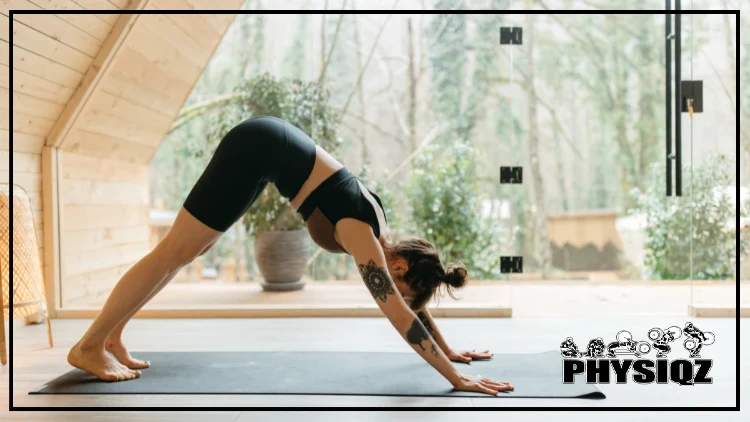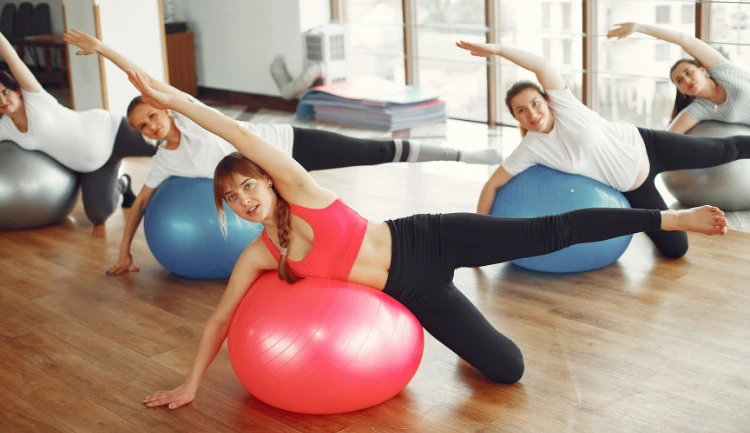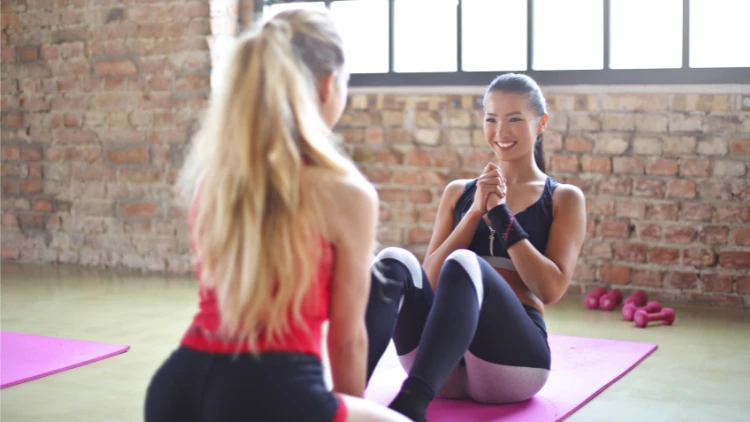
Pilates has gained tremendous popularity worldwide and continues to grow, but despite claims suggesting it’s the ultimate exercise for weight loss, I can assure you as a Pilates instructor that this belief is unfounded.1
Let me explain.
While Pilates can offer weight loss results, it’s not ‘the best’ since the best workout routine takes into consideration a persons goals, mobility, exercise preferences, and any other limitations.
That being said, it’s an awesome workout for most and surely worth giving a try.
But before giving Pilates a shot, check out how many calories can be burned using our calculator, how much weight can be lost, whether or not it tones the upper, lower or abs, see a few before and after pictures for inspiration, and then get started on the easy to follow Pilates program below.
Can Pilates Aid in Weight Loss? Understanding Its Impact on Your Body
Pilates is beneficial for weight loss because it helps burn calories, tone muscles, and offers a low-impact option for exercise, making it suitable for beginners, seasoned dieters, and those with joint or mobility concerns.
It’s an all around great workout to use and while there’re many Pilates instructors who may say that Pilates is 100% the best for weight loss but being an instructor myself, I’m here to dispel that myth since the best is a vague term and any exercise that someone can do consistently and pain free is going to be best for that individual.
Not to mention, the best routine for weight loss will vary from person to person based on what they enjoy doing and their overall fitness goals too. Someone looking to be mobile my enjoy yoga more, while someone solely focused on tone muscles and weight loss may benefit from weight lifting more.
But luckily Pilates is good for weight loss, toning, and for mobility so it’s a triple whammy!
Benefits of Pilates for Weight Loss
Pilates is one of many ideal weight loss solutions for several different reasons…
First, engagement in Pilates classes can help to boost a person’s metabolism. This means that the body is burning more calories to engage in its daily activities, resulting in less calories being stored as fat for energy.
Additionally, the body will start to burn off its fat reservoirs for energy, helping to lose weight and troublesome body fat.
On top of boosting metabolism, Pilates also helps to build and tone the abs, upper body, and lower body muscles. This is great for weight loss, because the more muscle a person has, the more calories their body will burn, even when resting.
Dieters should keep in mind that weight loss is dependent on a person’s caloric deficit, or more simply put, the amount of calories burned compared to the amount of calories eaten.
Research shows that the bigger the deficit, the greater the weight reduction.2 Because Pilates increases the caloric deficit of a person, it directly is responsible for achieving significant weight loss.

Source: Gustavo Fring via Canva.com3
When it comes to weight loss rules, a healthy diet is number one and don’t worry, because you don’t have to eat 100% healthy off the bat and small adjustments are actually better for longevity sake.
So dieters wanting to maximize the amount of pounds lost should make sure to eat healthy foods such as fruits, vegetables, and lean protein.
Trying to count calories or simply following intuitive eating while making low calorie dietary choices will help to speed up weight loss results.
Calories Burned in Pilates Classes: Calculate Your Pilates Caloric Expenditure
Now that readers know that Pilates is a great tool for weight loss, it begs the question of how many calories are burned per in a pilates class. The answer is a little bit tricky.
The number of calories burned during a Pilates workout will depend on several factors, including how much the person weights, the intensity level of the class, and the length of duration of the Pilates workout. Even characteristics such as sex and age can impact the amount of calories required per class.
On average, a person can expect to burn somewhere 218 calories per one hour session if they weigh 120 lbs, or 363 calories if they weigh 200 lbs. Factors that play a role will be the persons’ weight and intensity of the class.
Which goes to say, the actual number of calories burned can vary widely from person to person, so this is just a gross estimation for the average individual.
To get the most accurate estimate of how many calories are being burned during a Pilates class, try using a heart rate monitor or fitness device that can track activity level (such as the apple watch or the fitbit). This can take into account a person’s biometric data to best calculate energy expenditure.
Don’t worry, these fancy electronics aren’t necessary.
Simply use our online Pilates calculators to approximate the amount of calories burned.
Or, you can use the equation below to estimate calories burned using Pilate’s MET value.
The MET value stands for the metabolic equivalent of task, and is a numerical system that can be used to estimate the amount of energy required based on the amount of oxygen consumed.4 The MET value of Pilates is estimated to be around 4.0, making it a moderately intense activity.5
4 (Pilates MET Value) x Body Weight (kilograms) x time (hours) = Calories burned
To convert body weight into kilograms, simply take how many pounds weighed and divide that number by 2.2. Here is what the equation will look like:
Body Weight (pounds) / 2.2 = Body Weight (kilograms)
As an example, if you weight 150 pounds then your weight in kilograms would be 68.18 kilograms. So if you workout for half an hour, then the calories burned equals 136.36 for a half hour Pilates session.
4 (Pilates MET Value) x 68.18 kilograms x .5 (hours) = 136.36
Can You Lose a Bunch of Weight With Pilates? How Much?
Typically, when someone is considering Pilates for weight loss, they’re often interested in how much weight they can lose through Pilates.
Luckily for Pilates lovers, there is no limit to the amount of pounds that can be lost! Engaging in a workout regimen such as Pilates can be the key to achieving weight loss within just 7 days.
However, similar to the amount of calories burned discussed above, the amount of weight lost will depend on a number of different factors including the person’s starting weight, their diet, their overall lifestyle, and of course, how regularly they do Pilates.
Completing Pilates workouts for multiple days per week will help burn the most calories to achieve the maximum amount of weight loss that is possible.
With that being said, diet and training fatigue can occur if a person is eating too little or overworking their muscles. Pilates attendees should be aware of the signs of both such as increased tiredness, prolonged muscle soreness, low energy, headaches, dehydration, or lightheadedness.
If a dieter is experiencing these symptoms then it might be best to take a few extra rest days to allow the body to recover, and increase the amount of calories consumed per day. Research recommends combating fatigue symptoms with lots of hydration and electrolytes.6
Benefits of Pilates for Muscle Toning: Targeted Muscle Groups in Pilates
Pilates is an ideal routine for toning because it helps to burn fat and harden muscles. Pilates can target the entire body including the chest or pecs, the deep and superficial back muscles including the lats and traps, the glute muscles of the buttocks, and the leg muscles like the quads, hamstrings, and calves.

Source: Gustavo Fring via Canva.com7
Does Pilates Workout the Upper Body?
Pilates not only aids in weight loss but also effectively tones upper body muscles by engaging the hands and arms in various movements.
While Pilates primarily focuses on strengthening the muscles of the core, it also emphasizes proper posture and spinal alignment, which engages the muscles in the upper body. This is particularly good for the back and chest muscles.
Using an upper body designated program will also hit the arms and shoulders too. By completing a Pilates routine regularly, a person can expect to see significant improvement in the strength and tone of their body.
Does Pilates Target the Lower Body?
Luckily for those who are interested in adding Pilates into their routine, Pilates will target the leg and buttock muscles to help lift, tone, and grow the lower body.
Many of the movement exercises involved in a Pilates class will specifically engage the hamstring and quads of the upper thigh, the glute muscles of the buttocks, as well as the calf muscles too.
As Pilates workouts help to burn more calories, and therefore more fat, the legs along with the rest of the body will lean out getting a more defined and toned look. Because Pilates will also engage the lower body muscles, an exerciser will begin to notice changes such as muscle gain and improved strength.
Can You Get Abs by Doing Pilates?
The answer is yes! A person will be able to get abs from consistent attendance in a Pilates class. In fact, Pilates is specifically designed to engage the core muscles, which include all three layers of the “abs” or the muscles of the abdomen.
With regular integration of Pilates in one’s workout routine, a person will likely see both improvement in the strength and definition of their abs. By working out these muscles often, a hardening effect will also take place to give the abdominals a more toned appearance.
Studies have determined that exercise alone is not always enough to get visible abs, helping to prove the saying that abs are made in the kitchen.8
In fact, having visible abs is largely determined by a person’s body fat percentage. The lower the body fat percentage, the more visible the abs will appear.
This is very obtainable for most people, with the use of regular exercise and a healthy diet.
If getting visible abs is the goal, a person should aim to create a significant caloric deficit to aid in weight loss. They should also integrate Pilates programs and ab exercises in their workout routine to improve the definition of that muscle.
Finally, keeping an active lifestyle will further help to build lean muscle mass and increase fat burning.
Pilates Weight Loss Results With Pictures (Before & After Body Transformations via Pilates)
Nothing is more motivating than before and after pictures! So take a moment to view these amazing before and after results of consistent Pilates classes.
Don’t be afraid to try a 30 day weight loss challenge too!
Ashley Michelle
Ashley started her 30 day Pilates fitness journey to not only help to improve her health and physique, but to improve her mental health too. She bravely opens up to her audience about her grandmother’s passing and struggles with depression being the reason for attempting this challenge.
She was able to increase her fitness, but more importantly, found that the Pilates really helped with her mental health, and has helped to inspire countless others to take care of their mental health too.
Her incredible results can be seen here:
Libby Horner
Libby is a content creator who enjoys making lifestyle, self-improvement, beauty and fashion related videos on Youtube’s platform.
In 2021 she decided to complete a 28 day “Blogilates” challenge and tape her progression, as well as the ups and downs of doing an intense month-long program. She provides a very real insight into her fitness journey by being so open with her viewers.
Update: Libby has since set her vide to private but if it ever comes back online, here is her Pilates results.
Leah Miller
Leah is another content creator and property developer who is passionate about many topics, including skin care, personal development, and travel. She details her 6 week long pilates progression in a vlog style format, with frequent check-ins to show her progress.
Here is her 6 week program results:
The Best Pilates Weight Loss Programs for Whole Body Toning & Recomposition
The following Pilates programs can be done as often as desired. Simply follow along with the instructors through the whole video, or up the intensity by completing additional sets and reps.

Source: Andrea Piacquadio via Canva.com9
Readers are invited to try the sample 6 week program provided below. This program used progressive overloading by increasing the amount of sets and reps each week since research suggests this technique maximizes muscle growth.10
Note, this program details a suggested schema to follow in a sets x reps format. So if it says 1×12, you’ll do 1 set of 12 repetitions.
Week 1
- Day 1: Arms and Abs, 1X12
- Day 2: Lower Body, 1X12
- Day 3: Rest
- Day 4: Cardio
- Day 5: Arms and Abs, 1X12
- Day 6: Lower Body, 1X12
- Day 7: Rest
Week 2
- Day 1: Arms and Abs, 2X12
- Day 2: Lower Body, 1X15
- Day 3: Rest
- Day 4: Cardio
- Day 5: Arms and Abs, 2X12
- Day 6: Lower Body, 1X15
- Day 7: Rest
Week 3
- Day 1: Arms and Abs, 2X15
- Day 2: Lower Body, 2X12
- Day 3: Rest
- Day 4: Cardio
- Day 5: Arms and Abs, 2X15
- Day 6: Lower Body, 2X12
- Day 7: Rest
Week 4
- Day 1: Arms and Abs, 3X12
- Day 2: Lower Body, 2X15
- Day 3: Rest
- Day 4: Cardio
- Day 5: Arms and Abs, 3X12
- Day 6: Lower Body, 2X15
- Day 7: Rest
Week 5
- Day 1: Arms and Abs, 3X15
- Day 2: Lower Body, 2X20
- Day 3: Rest
- Day 4: Cardio
- Day 5: Arms and Abs, 3X15
- Day 6: Lower Body, 2X20
- Day 7: Rest
Week 6
- Day 1: Arms and Abs, 3X15
- Day 2: Lower Body, 2X20
- Day 3: Rest
- Day 4: Cardio
- Day 5: Arms and Abs, 3X15
- Day 6: Lower Body, 2X20
- Day 7: Rest
When it comes to cardio, readers can try out the cardio based Pilates program listed below, or any of their preferred cardio based activities. This might include running, swimming, spin class, or dance. Don’t be afraid to mix it up and try something new, too!
Arms & Abs Pilates Program
This program is great for burning fat and toning the upper body muscles. It includes a lot of floor work to engage the abs, classic Pilates movements such as planking, arm circles, and tricep dips.
Use this program about two times per week to achieve great looking arms.
Lower Body Toning Pilates Routine
Here is an ideal lower body program to tone the buttocks and thighs. Exercise highlights during this workout feature body weight squats, glute kickbacks, lunges, and glute bridges.
Try to use this program twice per week, with a rest day afterward to help the body recover.
Cardio Pilates Workout
This program is cardio heavy and hits the entire body. It can be used as often as desired, but the provided program calls for just once per week.
Expect to see squats, lateral leg raises, and v ups to name a few.
Pilates is a great exercise that has the potential to tone all the muscles in the body. Indeed, Pilates is highly effective for weight loss due to its low-impact nature and its ability to engage the entire body in a comprehensive exercise regimen, making it accessible to everyone.
Frequently Asked Questions
Can You Lose Weight With Pilates Without Dieting?
The answer is yes, although the weight loss results might not be as extreme. Because Pilates helps those to burn more calories than they normally would through activity, individuals should be able to still lose weight provided their diet remains stable. Research shows that not dieting can be compensated for by lazy girl weight loss hacks, such as eating portion controlled products.
Is Pilates the Best Form of Exercise for Weight Loss or Should I Do Other Types of Exercise?
Pilates can be great for those who are tired of being fat and struggling with losing pounds, but dieters should understand that there is no one form of exercise that is best for weight loss! In fact, the best workout is the workout that gets done consistently. Dieters who want to lose weight should incorporate exercises that they most enjoy such as dancing, cycling, or weight lifting.
References
1Shuraeva, Anastasia. Canva. Accessed 19 April 2023. <https://www.canva.com/photos/MAEc7wPTrXE-a-woman-bending-forward-on-the-yoga-mat/>
2Strasser, B., Spreitzer, A., & Haber, P. (2007). Fat loss depends on energy deficit only, independently of the method for weight loss. Annals of nutrition & metabolism, 51(5), 428–432. <https://doi.org/10.1159/000111162>
3Fring, Gustavo. Canva. Accessed 19 April 2023. <https://www.canva.com/photos/MAEkTLsCdR4/>
4Jetté, M., Sidney, K., & Blümchen, G. (1990). Metabolic equivalents (METS) in exercise testing, exercise prescription, and evaluation of functional capacity. Clinical cardiology, 13(8), 555–565. <https://doi.org/10.1002/clc.4960130809>
5Pacific Lutheran University. (n.d.). Average MET Values for Activities with Fitness Components (Activity Intensities are 3 METS or Higher). PLU. Retrieved December 16, 2022, from <https://community.plu.edu/~chasega/met.html>
6Dennis, S. C., Noakes, T. D., & Hawley, J. A. (1997). Nutritional strategies to minimize fatigue during prolonged exercise: fluid, electrolyte and energy replacement. Journal of sports sciences, 15(3), 305–313. <https://doi.org/10.1080/026404197367317>
7Fring, Gustavo. Canva. Accessed 19 April 2023. <https://www.canva.com/photos/MAD9exKQC2g-cheerful-group-of-pregnant-women-practicing-yoga-in-modern-studio/>
8Vispute, S. S., Smith, J. D., LeCheminant, J. D., & Hurley, K. S. (2011). The effect of abdominal exercise on abdominal fat. Journal of strength and conditioning research, 25(9), 2559–2564. <https://doi.org/10.1519/JSC.0b013e3181fb4a46>
9Piacquadio, Andrea. Canva. Accessed 19 April 2023. <https://www.canva.com/photos/MADGyWPaSZI-woman-with-red-top-and-black-shorts-on-purple-yoga-mat/>
10Peterson, M. D., Pistilli, E., Haff, G. G., Hoffman, E. P., & Gordon, P. M. (2011). Progression of volume load and muscular adaptation during resistance exercise. European journal of applied physiology, 111(6), 1063–1071. <https://doi.org/10.1007/s00421-010-1735-9>